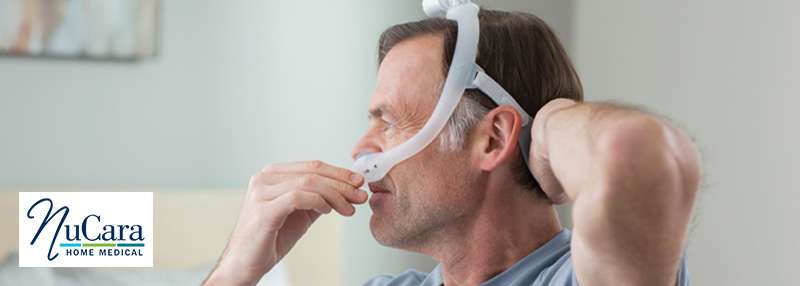NuCara Home Medical
Updated Tue November 25, 2025
Published Under: CPAP Masks

If you’ve ever woken up to the uncomfortable surprise of water in your CPAP mask or tubing, you’re not alone, and you’re not doing anything wrong. What you’re experiencing is called CPAP rainout, and it’s a common issue for many people using CPAP or BiLevel therapy.
Luckily, it’s a fixable problem. At NuCara Home Medical, we help patients every day troubleshoot PAP therapy discomforts like this and get back to sleeping peacefully.
Today, we’ll explain what rainout is, why it happens, and most importantly, how you can stop it so you can wake up feeling refreshed, not soaked.
What Is CPAP Rainout?
CPAP rainout is the term used to describe the build-up of condensation inside your CPAP tubing or mask. This usually occurs when the warm, moist air from your CPAP humidifier hits cooler tubing or room temperatures, causing the moisture to condense into water droplets, similar to how a cold drink “sweats” on a hot day.
When enough condensation collects, it can:
- Pool in your mask or tubing
- Create loud gurgling or sloshing noises
- Splash on your face while you’re sleeping
- Cause air pressure disruptions
- Wake you up and ruin a good night’s rest
What Causes Rainout in CPAP Therapy?
Several common factors can contribute to rainout. Understanding these can help you pinpoint the fix that works best for you:
- Cool bedroom temperatures – especially during fall and winter
- High humidifier settings – too much moisture in the airflow
- Lack of heated tubing – which allows the air to cool and condense
- Long tubing runs – more time for air to lose heat
- Mask style and design – nasal pillows and certain nasal masks are more prone to condensation
- Body or room temperature changes overnight
If this sounds familiar, don’t worry. There are several easy and effective ways to manage—and eliminate—rainout. Need help?
Contact Us Today for CPAP Support
How to Stop Water from Collecting in Your CPAP Mask and Tubing
1. Use Heated Tubing
One of the most effective solutions for rainout is switching to heated tubing, which keeps the air temperature consistent from the machine to your mask.
By maintaining warmth throughout the tube, heated tubing prevents condensation from forming, which means no water buildup, no gurgling, and no surprise wakeups.
NuCara Tip: Most major CPAP machines have heated tubing options. We can help you find compatible heated tubing for your specific device.
2. Adjust Your Humidifier Settings
Your CPAP humidifier adds moisture to the air you breathe, helping prevent dryness in your nose and throat. But if the humidity setting is too high, it can lead to excessive moisture and, eventually, rainout.
Try lowering the humidifier level slightly and see if that helps. If your device has auto humidification mode, turn it on as it will adjust moisture levels based on your room’s temperature and humidity.
3. Place Your CPAP Machine Lower Than Your Head
Let gravity help you. When your machine is positioned lower than your sleeping position, any condensation that forms is more likely to drain back into the machine rather than pooling in your mask or tube.
A lower shelf on your nightstand, a footstool, or a purpose-built CPAP stand are all good options.
4. Insulate Your CPAP Hose
If you don’t have heated tubing, adding a CPAP hose cover or wrap can help reduce temperature drops along the tube’s length. These covers act as insulation and are especially useful in colder bedrooms or during winter months.
Hose covers are inexpensive, easy to install, and available at NuCara.
5. Keep Your Bedroom Temperature Stable
Rapid shifts in temperature between your room and your tubing are a major cause of condensation. Try to:
- Avoid turning your thermostat down too low at night
- Use blackout curtains to reduce nighttime cold drafts
- Place your CPAP machine away from vents or windows
A small space heater or adjusting your central air just a few degrees higher overnight can make a big difference.
6. Try a Different Mask Style
Some mask designs are more prone to condensation than others. Nasal pillow masks, for example, have shorter air paths and less surface area, which can lead to more noticeable rainout for some users.
If you’re consistently dealing with water in your mask, it may be time to explore alternative options like:
- A nasal mask with a diffuser
- A full face mask
- Masks with built-in moisture control features
NuCara Tip: Not every mask works for every person or environment. Our team is here to help you find the best fit for your comfort and needs.
When to Call NuCara for Support
If you’ve tried several of the fixes above and are still dealing with rainout, it may be time to reach out. We can help you:
- Adjust your machine settings
- Choose compatible heated tubing or accessories
- Try a new mask design
- Troubleshoot your setup to find the ideal solution
At NuCara Home Medical, we specialize in helping patients feel comfortable and confident in their CPAP therapy, because good sleep shouldn’t be a struggle.
Contact Us for CPAP Help
Don’t Let Rainout Interrupt Your Rest
Rainout may be a common CPAP problem, but it’s one you don’t have to live with. With a few simple adjustments, like adding heated tubing, insulating your hose, or adjusting humidity settings, you can wake up dry, refreshed, and ready to take on the day.
And remember, if you’re ever unsure or need a second opinion, NuCara is here to help. Our experts can guide you to the best solutions for your unique setup so your sleep therapy supports—not disrupts—your night.
Check Out NuCara CPAP Products
Comments